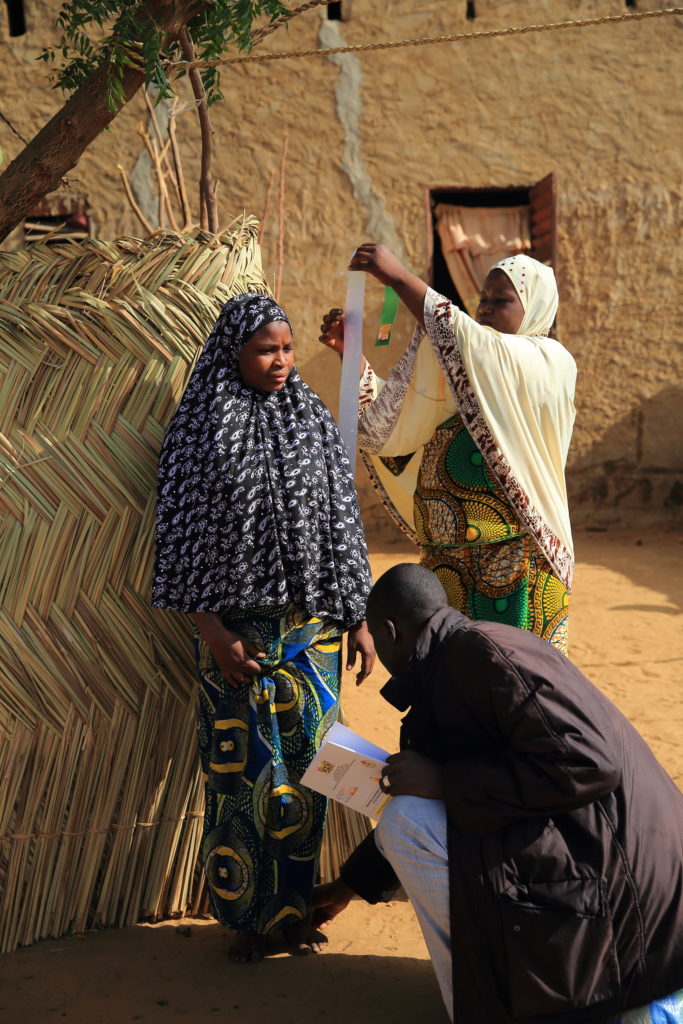NTDs in Burkina Faso: Current Epidemiological Status of Neglected Tropical Diseases Targeted through Preventive Chemotherapy
April 1st, 2018
Located in West Africa, Burkina Faso is home to approximately 20 million people. In 2006, the country began receiving support from the US Agency for International Development (USAID) through the END in Africa project,[1] for the control and elimination of the seven neglected tropical diseases (NTDs) targeted through preventive chemotherapy (PC NTDs), which include onchocerciasis (river blindness), lymphatic filariasis (elephantiasis), trachoma, schistosomiasis (bilharzia), and three types of worm infections (roundworm, whipworm, and hookworm).
When the END in Africa project first began operating in Burkina Faso in October 2010, many of the country’s citizens, known as Burkinabes, were suffering from one or more of the seven NTDs. Out of a total of 70 health districts (HDs), river blindness existed in 6 HDs, trachoma was present in 48 HDs, and all 70 HDs had transmissible cases of elephantiasis, bilharzia, and the three types of worm infections. This meant that to eliminate or control these diseases, every single age-eligible Burkinabe in each affected HD had to be treated with medicines capable of curing and preventing each NTD.
As the lead partner in the END in Africa consortium, FHI 360 has been supporting Burkina Faso’s Ministry of Health to increase coverage of all NTD interventions, as well as strengthening its capacity to better manage integrated NTD programs. This support has included coordinating and providing technical assistance and administrative services to Burkina Faso’s national NTD program (NTDP) to build the country’s capacity building to manage integrated NTD programs, including work planning, monitoring and evaluation, data management, supply chain management, quality assessment, and financial management, with on-the-ground support from implementing partner Helen Keller International (HKI).
With END in Africa support, over 66 million Burkinabes have been treated and over 134 million treatments have been administered (both numbers are cumulative) over 7 years of project implementation in Burkina Faso. During the time that the country has received END in Africa support, Burkina Faso has seen the following achievements:
- All 48 trachoma-endemic HDs have achieved the World Health Organization (WHO) criteria for stopping trachoma treatment and treatment was stopped. Post-treatment surveillance (PTS) for trachoma has started in all 48 HDs and will continue for 3–5 years. PTS will be followed by a pre-validation survey, after which a dossier will be prepared and submitted to WHO for verification of elimination of trachoma as a public health problem in the country.
- Sixty (60) of the 70 elephantiasis-endemic HDs have achieved the WHO criteria for stopping elephantiasis treatment and treatment was stopped. PTS for elephantiasis has started in the 60 HDs and will continue for 4–6 years. In addition, treatment of at-risk populations will continue in the other 10 HDs until they also reach the WHO criteria for stopping elephantiasis treatment. Then, they will also need 4-6 years of PTS. Once every elephantiasis-endemic HD has completed PTS for elephantiasis, the NTDP will prepare a dossier for submission to WHO for validation of elimination of elephantiasis as a public health problem in Burkina Faso.
Burkina Faso’s 6 river blindness-endemic HDs still need several years of river blindness treatment before they will meet WHO requirements for stopping treatments. Then, they will need to undergo 3–5 year of PTS before the country can prepare a dossier for submission to WHO for verification of river blindness elimination as a public health problem.
For bilharzia and soil-transmitted worm infections, the goal is less stringent than for trachoma, elephantiasis, and river blindness—transmission control as opposed to disease elimination. This is because environmental circumstances in Burkina Faso and the nature of these diseases do not permit their outright elimination as public problems at present. Therefore, END in Africa is supporting the country’s efforts to treat all at-risk populations at least once a year to maintain low levels of disease prevalence. In addition, ongoing research studies are continuously searching for better drugs, strategies, and tools that will eventually put an end to the transmission of these diseases, as well.
As this research continues, the END in Africa project’s legacy in Burkina Faso will continue, as well, due to the project’s sustainability approach, which goes beyond resource mobilization and involves the strengthening of the four foundational “building blocks” of financial analysis and strategy, advocacy and communications, strategic social partnerships, and organizational capacity. Adopting this approach is important because Burkina Faso will need financial, technical, and administrative support as it embarks on the ‘last mile’ to eliminate river blindness, elephantiasis and trachoma as public health problems and continues to maintain low levels of bilharzia and worm infections within at-risk communities.
On the whole, Burkina Faso has made significant progress toward controlling the seven NTDs, especially trachoma and elephantiasis. The results achieved over the past 7 years demonstrate the commitment of the MOH and the NTDP to controlling and eliminating the PC NTDs. Burkina Faso has had and continues to have many challenges along the way including political unrest, terrorist attacks, hard-to-reach areas, and limited human resource for health. These challenges, however, have not dampened the resilience of the Burkinabe people and the MOH in controlling the PC NTDs.
[1] The End Neglected Tropical Diseases in Africa (END in Africa) project is supported by the United States Agency for International Development (USAID) and managed by Family Health International 360 (FHI360). The project currently supports six countries (Burkina Faso, Cote d’Ivoire, Ghana, Niger, Sierra Leone and Togo) in efforts to control and eliminate seven neglected tropical diseases (NTDs): onchocerciasis or river blindness; lymphatic filariasis or elephantiasis; trachoma or blinding eye infection; schistosomiasis or bilharzia; and three types of worm infections—roundworms, whipworm and hookworm. Over 221 million people have received treatment for at least one of these seven NTDs and over 464 million treatments have been administered in the 6 countries between October 2010–September 2017).


